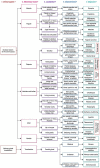Oral lesions of viral, bacterial, and fungal diseases in children: A decision tree
- PMID: 35958174
- PMCID: PMC9358008
- DOI: 10.3389/fped.2022.937808
Oral lesions of viral, bacterial, and fungal diseases in children: A decision tree
Abstract
Oral mucosal lesions are common in the pediatric population and, apart from traumatic and tumoral etiologies, they can be symptoms of viral, bacterial, fungal or parasitic diseases. Yet, pediatricians and pediatric dentists find it challenging to reach a diagnosis and provide appropriate care when facing lesions of the masticatory or lining mucosa, of the hard or soft palate, of the tongue or salivary glands. Here, we propose a decision tree for the diagnosis of the most frequent viral, bacterial, and fungal diseases starting from their oral lesions in children. By first focusing on describing the elementary lesion itself before its localization and characteristics, it aims to guide the practitioner toward the diagnosis and any necessary complementary exams. To generate this tool, we conducted a literature review of the childhood viral, bacterial, fungal and parasitic diseases with oral mucosal symptoms. For each of the 42 reported diagnoses-20 viral, 9 bacterial, 5 fungal, and 8 parasitic-we collected the infection mechanism and agent(s), the oral lesions and their description, the associated systemic signs and the incidence/prevalence. In fine, our decision tree indexes the 28 diseases for which epidemiological data was available, mainly in Europe and the United States.
Keywords: communicable diseases; decision trees; mouth mucosa; oral manifestations; oral medicine; pediatric dentistry.
Copyright © 2022 Guillouet, Riou, Duong, de La Dure-Molla and Fournier.
Similar articles
-
Oral manifestations of AIDS in a heterosexual population in a Zaire hospital.J Oral Pathol Med. 1990 May;19(5):232-4. doi: 10.1111/j.1600-0714.1990.tb00832.x. J Oral Pathol Med. 1990. PMID: 2359042
-
Accuracy of pediatric primary care providers' screening and referral for early childhood caries.Pediatrics. 2002 May;109(5):E82-2. doi: 10.1542/peds.109.5.e82. Pediatrics. 2002. PMID: 11986488
-
Oral signs and symptoms in 160 Greek HIV-infected patients.J Oral Pathol Med. 1992 Mar;21(3):120-3. doi: 10.1111/j.1600-0714.1992.tb00994.x. J Oral Pathol Med. 1992. PMID: 1316436
-
Epidemiology of the most common oral mucosal diseases in children.Med Oral Patol Oral Cir Bucal. 2005 Nov-Dec;10(5):376-87. Med Oral Patol Oral Cir Bucal. 2005. PMID: 16264385 Review. English, Spanish.
-
Common oral manifestations of systemic disease.Otolaryngol Clin North Am. 2011 Feb;44(1):161-82, vi. doi: 10.1016/j.otc.2010.09.006. Otolaryngol Clin North Am. 2011. PMID: 21093628 Review.
Cited by
-
[Prevalence of dental and mucosal lesions among the pediatric population who attended the emergency department of a general hospital].An Sist Sanit Navar. 2023 Aug 28;46(2):e1041. doi: 10.23938/ASSN.1041. An Sist Sanit Navar. 2023. PMID: 37635690 Free PMC article. Spanish.
-
Oral Manifestations in Children Diagnosed with COVID-19: A Narrative Review.Healthcare (Basel). 2023 Jan 17;11(3):288. doi: 10.3390/healthcare11030288. Healthcare (Basel). 2023. PMID: 36766863 Free PMC article. Review.
-
Intraoral Soft Tissue Lesions in 6-Year-Old Schoolchildren in Regions of Southern Ecuador: An Epidemiological Study.Children (Basel). 2024 Mar 29;11(4):406. doi: 10.3390/children11040406. Children (Basel). 2024. PMID: 38671623 Free PMC article.
References
-
- Rioboo-Crespo M del R, Planells-del Pozo P, Rioboo-García R. Epidemiology of the most common oral mucosal diseases in children. Med Oral Patol Oral Cirugia Bucal. (2005) 10:376–87. - PubMed
LinkOut - more resources
Full Text Sources


